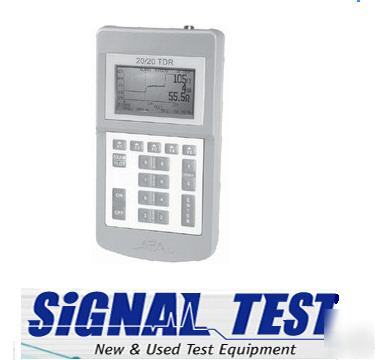TENNESSEE EQUIPMENT MODERATED NEWSGROUP AND LIST > West Cost
> California
> Aea tech time domain reflectometer 20/20 tdr f and RJ45
Aea tech time domain reflectometer 20/20 tdr f and RJ45
When you purchase one of these please specify which configuration you would like you can call us Toll Free in the USA at 1-(***)-744-3014 or at (***)-575-1577!! Prices are the same for these rechargeable 20/20 models these are equipped with F and RJ45 Connectors
* Model: 20/20F Network TDR, Part Number: 6020-5041, Option: CATV, Equipped: “F†and “RJ-45†style connectors
* Model: 20/20F Network TDR, Part Number: 6020-5042, Option: Telco, Equipped: “F†and “RJ-45†style connectors
* Model: 20/20F Network TDR, Part Number: 6020-5043, Option: VDV/RF, Equipped: “F†and “RJ-45†style connectors
* Model: 20/20B Network TDR, Part Number: 6020-5053, Option: VDV/RF, Equipped: “BNC†and “RJ-45†style connectors
AEA 20/20 N TDR Cable Tester with N connector for the Communications Industry.
Choose from any of the following configurations below
The 20/20 TDR product line is a family of “Step†Time Domain Reflectometers designed for the Communications, Telephone, Broadband, and Private Network markets or wherever high bandwidth copper media testing is required. The 20/20 TDR models identify and pin-point faults in all twisted pair and coax cables. The advantages of the 20/20 TDR’s step technology are the elimination of dead zones; increased informational data at the cursor location such as distance and impedance, plus higher resolution and greater accuracy over traditional pulse TDR’s. The 20/20 TDR features include multiple display formats, an intermittent fault capture, and a pair-balance test (Multi-Channel only). You can store up to 99 screen traces or 15 full range traces in the TDR memory for retrieval or downloading to the new TDR PC Vision TM software.
All Time-Domain-Reflectometer (TDR) devices are built on the same general principle. Radio Frequency waves travel at a speed that can be measured. The speed of the RF signal varies depending on the material it is traveling through. RF travels fastest through vacuum (100%) and slowest through twisted wire pair (50% to 75%).
When RF encounters an obstacle or impedance shift in twisted wire pair or Coaxial cable, some or all of the energy bounces back towards the origin end. The time it takes for this bounced energy or reflection to arrive back at the source is measured and divided by two to account for the round trip. If the Velocity Factor or Velocity of Propagation (VoP) of the medium is known, the time can be translated into an accurate distance measurement. The following equation expresses the TDR’s basic principle of operation: Time/2 X Velocity = Distance Step verses Pulse Technology Pulse technology is similar to AM Radar, where a short burst of a sine wave is transmitted. The transmitter emits a single pulse then shuts off. The TDR then enables the receiver to listen for reflections. The longer the transmitted pulse, the longer the distance before the receiver can start looking for reflections. This is called the “Dead Zone†or “Blind Spotâ€, and can be quite long in less expensive TDRs. Pulse technology can only measure the time between reflections and cannot interpret information between reflections such as gradual cable losses. The width of the pulse needs to be set by the operator, using a shorter pulse reduces the Dead Zone but limits the range. The longer pulse widths have good range but a correspondingly larger Dead Zone. The pulse, when compared to a step TDR, has less signal energy which results in a plot that has a lower signal to noise ratio and a less clear picture of the cable. Step Technology is more like a Doppler radar, where the transmitter always emits energy while the receiver simultaneously listens for returned signals. This eliminates the “Dead Zone†pitfall of pulse technology, and allows the receiver to “see†right from the TDR’s connector. Since the receiver looks at a constant signal, it accurately detects information that the pulse types cannot such as the cable’s impedance along it’s length. Due to the higher energy in a step signal TDR, the signal to noise ratio is improved. Couple this with the addition of noise filters and you can effectively reduce or eliminate outside interfering noise with less degradation of the received signal.
8 AA Alkaline Batteries Nonrechargeable
All rechargeable TDR’s come with 8 AA NiMH cells installed. Some non-rechargeable models come with 8 AA alkaline cells installed. Replacement NiMH cells are available from AEA Technology (P/N 0010-0218) or can be replaced with any reliable commercial brand sold in local stores. Additionally, rechargeable units can operate on AA alkaline cells and non-rechargeable units can operate on externally recharged AA NiMH or NiCd cells.
CAUTION: You should never mix cells. All 8 cells should be replaced at the same time and with the same type of cell. TDR 20/20 TDR 20/20

